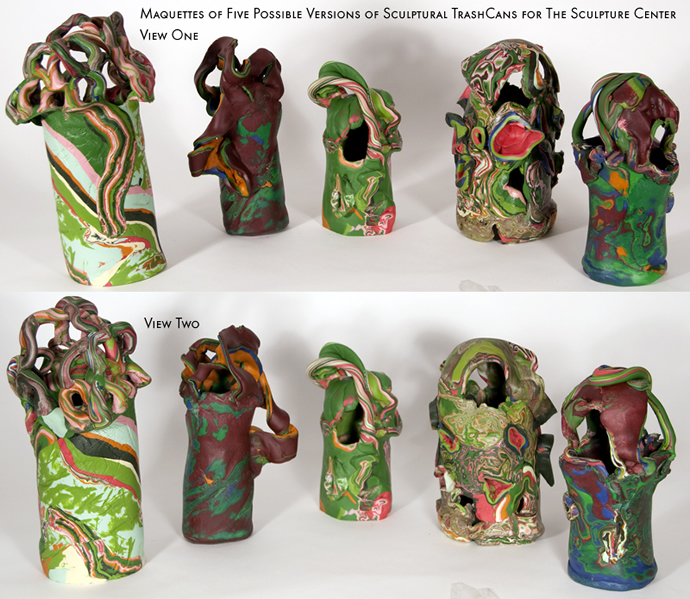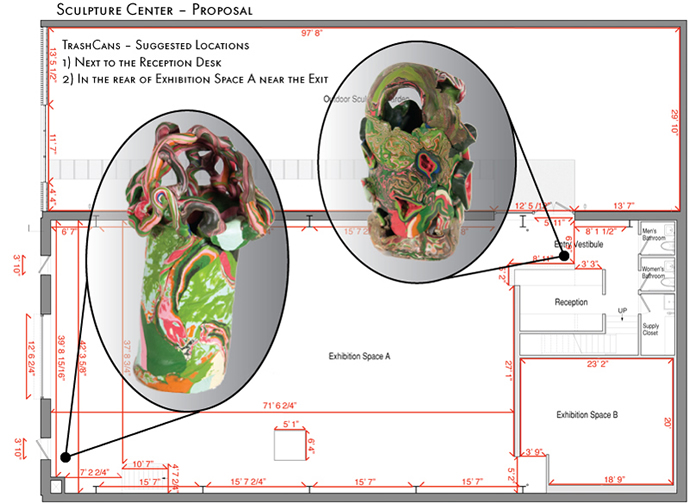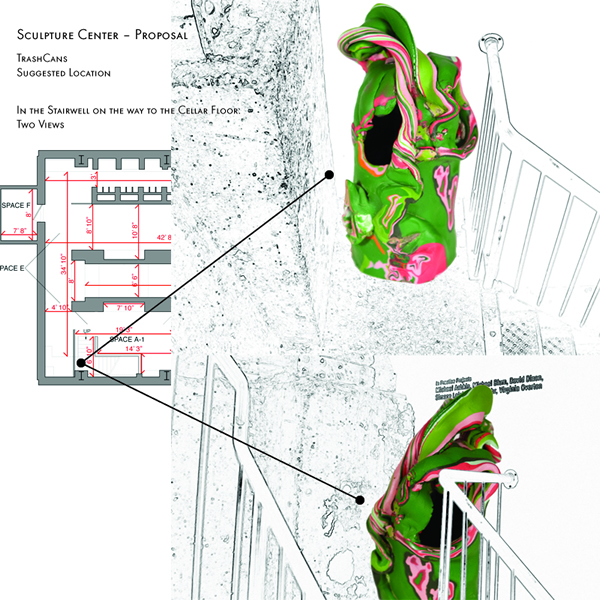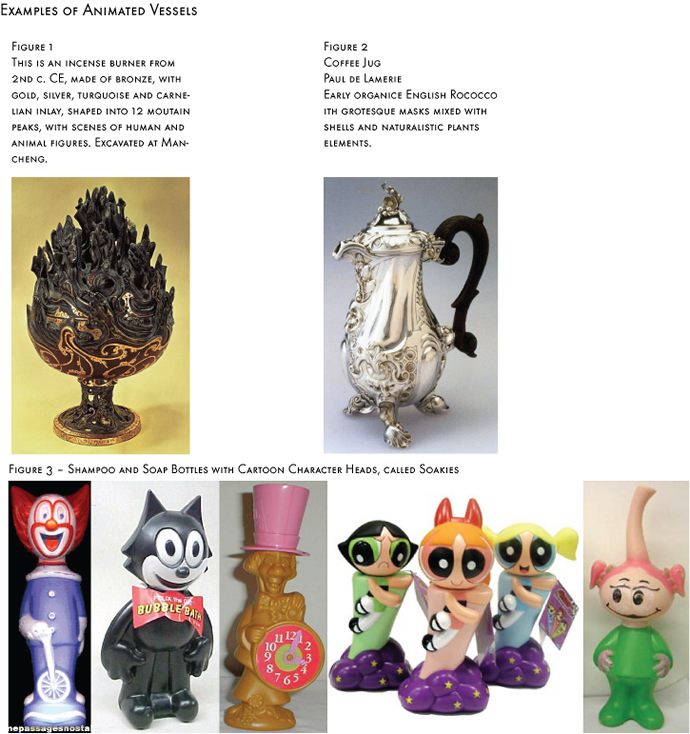Proposal for the Sculpture Center 2009
PROPOSAL: THE SHORT VERSION
I propose to make 3 sculpture/trash cans to be placed in appropriate locations throughout the Sculpture Center. Each sculpture/trashcan will be fully functional as both trashcan and sculpture. See the images below for suggested placement of the sculpture/trash cans and photographs of maquettes.



PROPOSAL: THE LONG VERSION
THREE REASONS MY SCULPTURE AND TRASH CANS HAVE SO MUCH IN COMMON
The Trojan Trash Can
Sculptures take up much space and therefore require a large and unusual commitment from the user. Recently I’ve been sneaking sculpture into everyday environments in the guise of other kinds of object. I’ve challenged myself to see sculpture as a table or half-table half-sculpture or a vase. The uselessness of sculptural reverie enters the functional object like a Trojan Horse. So why not a trashcan?
Animated Vessels
Throughout time vessels have taken on the form of many living things – animals, human bodies, faces, body parts, plants and mythical beings. The source for an animated vessel is the comparison of forms – the weaving tendrils of incense smoke mirrored in the peak of the lid of an incense burner (see image below, figure 1), the ocean spewed from the mouth of Neptunein a column of fury is like the leg of a Rococco coffee pot (see image below, figure 2), and the head of cartoon characters is likened to the cap of a soap bottle. (see image below, figure 3). Algorithm for a Crazy Vase on a Table shows one of my more abstract animated vessels. I imagine a trashcan as an animated vessel – a hybrid of object and imagination.

Obscure Spaces Hide Garbage
I see my sculpture/trashcans as interactive. Imagine placing your hand into the dark unknown hole of a sculpture and dropping your waste into its unseen center. In contrast to much modern and contemporary sculpture where what you see is what you get, not every surface of my sculptures can be seen. In holes and crevices, forms are obscured in the blackness of shadow. The dramatic use of light and shade is the physical equivalent for emotional states in my sculptures, “picturing” the hidden, discarded aspects of one’s interior life. A trash receptacle is the way-station for things we need to dispose, while sculpture, or at least my sculpture, is a container for inner garbage. My sculpture/trashcans are both.
TRASH AND SCULPTURE
Sculpture is made from throwaways.
There is a long history of using trash in sculpture from the collages of the Cubists, through Robert Raushenberg to Jessica Stockholder and Rachel Harrison. What happens when the terms are switched – the autonomous sculptural object contains the detritus rather than being made out of it?
Sculpture is thrown away
Having made sculpture for the last 30 years I have, like many sculptors, had to throw many sculptures away because I could not continue to store them. My sculpture/trashcans can be viewed as a memorial to all the sculpture that has been thrown away by my kindred out of creative necessity.
TRASHCANS IN SPACE
A Billion Turds
As a sculptor I have emphasized the private aspects of art-making, creating intimate emotionally-laden objects intended for the private musings of other individuals. Trashcans pose an intriguing intersection of the public and the private for an artist with my predilection. The trashcan is a public place to satisfy the private need to throw away one’s trash. In our era, a multitude of private acts have become a public crisis. The private need to flush away one’s waste becomes the public problem of what to do with a billion turds.
Hidden in Plain View
Trashcans are most often placed off to the side in unused spaces. They collect discarded objects, they reside in discarded places. At the opposite end of the spectrum, an art object is conventionally placed in the center of a room and spotlighted. The trashcan is meant to be invisible, except when needed, while an art object’s raison d’etre is to be seen. A trashcan may be a mobile and independent object but it shares the focus on forgotten spaces with site-specific intstallations. The challenge of creating sculpture/trashcans will be to make sure they are “hidden in plain view”.
The Trash Can as Watering Hole
In a motion study done by architects designing a kitchen, it was found that the place where “cooks” paths interesect most often is the trash can. Traffic bottlenecks occurred throwing trash away. They found that the trash can turns out to be a meeting place like a watering hole, or like the town square where all paths converge. Even though a trash can is placed out of the way, it is contradictorily a focal point. I plan to highlight the contradictory nature of trash cans in my project.
CONCLUSION
The long history of the Sculpture Center’s support for experimentation and play has inspired this project. I am very excited to propose these idiosyncratic objects meant to draw people to obscure places.